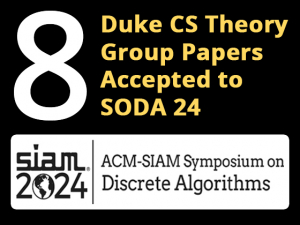Geometry is an essential part of the description of almost any object, phenomenon, or process in the physical world. It is thus not surprising that much of the data being gathered has a geometric character, either directly or indirectly. Examples of geometric data sets include images, videos, digital elevation models, 3-D urban scans, density maps from 3-D medical imaging, and so on. Furthermore, a wide array of techniques is being developed and deployed that map high-dimensional and ostensibly non-geometric phenomena, such as the behavior of users in a social network or a corpus of text documents, to geometric spaces using feature sets, revealing underlying geometric structures in data. Research in geometric computing at Duke focuses on modeling, analyzing, querying, and visualizing such geometric data sets, ranging from foundational questions such as geometric shape matching and proximity problems to applications of geometric algorithms in various areas including GIS, databases, data mining, molecular biology, and robotics.
- RJR Nabisco Distinguished Professor of Computer Science in Trinity College of Arts and Sciences
- James B. Duke Distinguished Professor of Computer Science
- Assistant Research Professor of Computer Science














